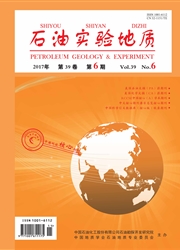

 中文摘要:
中文摘要:
根据最新的地震资料,运用断层相关褶皱理论和平衡剖面技术。对巴楚隆起中部卡拉沙依断层的差异变形特征进行了分析。卡拉沙依断层是巴楚隆起内部的多期活动断层,经历了加里东早期、加里东中期I幕、海西晚期和喜马拉雅早期等关键变形期。平面上卡拉沙依断层表现为2条规模不同的断层自南西向北东呈剪刀式会聚.剖面内卡拉沙依断层表现为由沿寒武系滑脱的坡坪式盲冲断层和基底卷入式高角度逆冲断层共同组成。含膏盐岩层系控制了卡拉沙依断层的分层变形特征,基底先存构造的差异性控制了卡拉沙依断层的分段变形特征,区域构造应力场转换控制了卡拉沙依断层的分期差异变形特征。
 英文摘要:
英文摘要:
Based on latest seismic interpretation data, the features of differential deformation of the Kalashayi Fault in the central Bachu Uplift were analyzed by means of fault-related fold theory and balanced section tech- nique. The Kalashayi Fault is an active fault of multiple stages in the Bachu Uplift. It has suffered several stages of deformation, such as the early Caledonian, the episode I of the middle Caledonian, the late Hercynian and the early Himalayan. On the plane, two faults of different scales converge like scissors from SW to NE. In pro- file, the Kalashayi Fault is composed of ramp-flat blind thrust fault which slips in Cambrian and high-angle basement-involved thrust fault. Gypsum-salt rocks control the multi-level deformation features of the Kalashayi Fault. The difference of pre-structure in basement leads to the segmental deformation features. Regional stress field transition results in the poly-phase deformation features.
 同期刊论文项目
同期刊论文项目
 同项目期刊论文
同项目期刊论文
 Structural deformation and fluid flow from East Sichuan to the northwestern periphery of the Xuefeng
Structural deformation and fluid flow from East Sichuan to the northwestern periphery of the Xuefeng Polygonal faults in the Sanzhao sag of the Songliao basin: their significance in hydrocarbon accumul
Polygonal faults in the Sanzhao sag of the Songliao basin: their significance in hydrocarbon accumul 期刊信息
期刊信息
